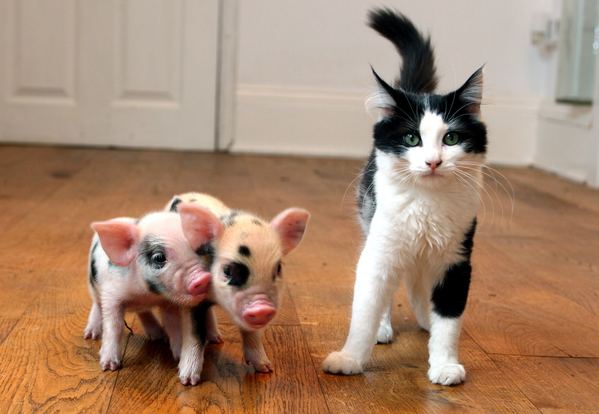Teacup pigs often marketed as small, adorable pets are gaining popularity as household animals. However, what many people don't know is that these “teacup” pigs are actually regular potbellied pigs that are often malnourished to remain small. While they might look cute in pictures, there are some important truths and myths about these pets that could affect both their health and your lifestyle.

Let’s explore what you need to know about teacup pigs and why they might not be the right choice for your home.
Contrary to popular belief, teacup pigs are not a unique breed. Instead, they are simply potbellied pigs that have been bred under unhealthy conditions to remain small. Often, breeders starve these pigs to stunt their growth, and they are frequently misrepresented as miniature animals.
While potbellied pigs are smaller than typical farm pigs usually weighing between 100 and 200 pounds teacup pigs are falsely advertised as staying only 10 to 12 pounds. Even the smallest potbellied pig will still weigh between 60 and 80 pounds when fully grown. Therefore, the promise of a "teacup" pig is often just a myth.
The term "teacup" pig is a marketing ploy. In reality, teacup pigs are not a distinct breed. They are regular potbellied pigs that have been bred or malnourished to stunt their growth. These pigs can grow significantly larger than the promised "miniature" size, often reaching 60-100 pounds or more, depending on their genetics and overall health.
Unfortunately, many teacup pig breeders use cruel methods like starvation or inbreeding to stunt growth. By restricting their food intake, breeders can prevent pigs from growing to their full size. While this keeps them small externally, it causes their internal organs to grow to full size, leading to health issues like bone deformities, organ failure, and reduced life expectancy.
Pigs that are malnourished or inbred may suffer from weakened immune systems, which can lead to frequent illness, joint problems, and even early death.
One of the major myths about teacup pigs is that you can predict how large they will grow based on their parents. This is not true. Because pigs can breed as young as three months old, "teacup" breeders often show you the parents when they are still just piglets themselves. As a result, it’s impossible to know how big your "teacup" pig will actually become once fully grown.
The price of a teacup pig can range from $750 to $3,500, but the cost doesn’t stop there. Teacup pigs require specialized care, including veterinary visits, a proper diet, and exercise. Many owners who buy these pigs don’t realize the cost of maintaining a pig that could eventually weigh over 100 pounds. On top of that, you might also need to find a vet experienced in treating pigs.
While healthy potbellied pigs can live anywhere from 12 to 18 years, teacup pigs often have a much shorter lifespan sometimes only 5 years. This is mainly due to health complications caused by malnutrition, inbreeding, and a weakened immune system.
Pigs are not your average small pets. They need ample space to roam, explore, and root around. If they don’t have enough room to move, teacup pigs can become bored and develop behavioral problems. They may even start to display aggression, which can lead to accidents or injuries.
Pigs are also incredibly social animals, meaning they need both physical and emotional space to thrive. Without proper care, they can become depressed, anxious, or overly aggressive.
Before purchasing a teacup pig, it’s important to check local laws and zoning regulations. In many places, owning pigs as pets is illegal because they are considered livestock. Some areas restrict pig ownership due to concerns about their size, space requirements, and environmental impact.
Pigs are highly social creatures. In the wild, they form complex social groups, and they prefer the company of other pigs. Owning just one teacup pig may lead to loneliness and depression for the animal. While it’s possible to keep them as solo pets, it’s recommended to have at least two pigs to meet their social needs.
Unlike dogs and cats, pigs have very specific needs that require constant attention. Teacup pigs are intelligent, but they can also be difficult to train. They need to be handled carefully and with patience, as they can develop behavioral issues if neglected or improperly trained. Many new owners underestimate how much work and money it takes to care for a pig, especially when the animal begins to grow larger than expected.
Pigs are not always friendly with other animals. In fact, they can have issues with other pets, such as dogs or cats, especially when it comes to food or territory. Although pigs are social with other pigs, they might not adapt well to other pets in the household. It's important to consider how your teacup pig will interact with your existing pets before bringing one home.
While teacup pigs may seem like an attractive choice for a small, adorable pet, they come with many challenges and responsibilities. These pigs are often misrepresented and can grow much larger than expected. Additionally, they require specialized care, including proper diet, space, and veterinary care.
Before purchasing a teacup pig, make sure to research the breed, understand the potential health issues, and consider the long term commitment involved. While teacup pigs can make wonderful pets for the right owners, they are not ideal for everyone. Ensure you’re ready for the responsibility that comes with owning a pig, and always choose a reputable breeder who prioritizes the health and well being of their animals.
animal tags: teacup-pigs
We created this article in conjunction with AI technology, then made sure it was fact-checked and edited by a Animals Top editor.